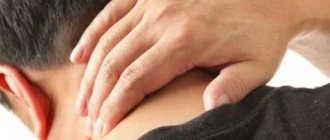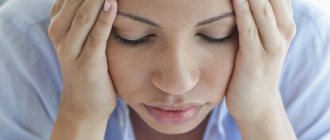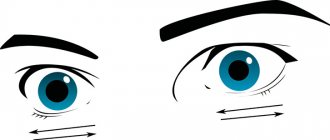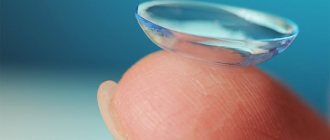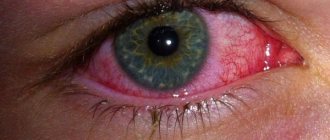Useful articles
Abuse or “rebound” headache is a pathology caused by the abuse of analgesics. It is the negative effect of drug treatment that is often detected in patients who complain of constant (daily) cephalgia. Treatment involves, first of all, stopping the uncontrolled use of painkillers and ergotamine.
Causes
The development of this type of cephalgia is caused by the abuse of analgesics, NSAIDs, triptans, serotonin agonists and ergotamine, in which the so-called “reverse effect” develops. Pathology develops when taking painkillers for at least 15 days a month, if taken for 3 months or more. This constant headache may appear after a few weeks, but usually only after several years of uncontrolled self-medication. When using over-the-counter painkillers, it begins on average after 4.7 years; for triptans, the time period is reduced to 1.7 years. Around the world, about 4% of the population suffers from headaches. It occurs twice as often in women as in men.
It is very dangerous to take mixed drugs - drugs containing one or more active substances acting on the peripheral nervous system, and one or more components acting on the central nervous system (especially caffeine or codeine). Unfortunately, such drugs are very popular among the population, but the body can get used to them. Subsequently, refusal of painkillers and psychostimulants provokes autonomic disorders. Patients, along with abusive headaches, experience increased sweating, nausea, and other symptoms of withdrawal.
Important: it is known that self-medication with analgesics for diseases not associated with cephalalgia does not lead to the development of the opposite effect.
What is an overuse headache?
Abuse headaches, also called “rebound” or drug headaches, are a secondary manifestation of cephalalgia, which is closely related to migraine.
Overuse headache is a pain that occurs when you take excessive pain medications.
The degree of development of the disease depends on the content of the drug in the blood; as the dose or frequency of administration increases, the pain also increases.
To confirm the diagnosis, it is necessary to check the level of drug concentration. Treatment consists of reducing the dose of the trigger medication.
Overuse of medications is considered to be the cause of overuse headaches. In recent years, the disease has become more common due to the sale of readily available painkillers.
Due to the fact that depressive conditions can contribute to abusive headaches, in addition to complete withdrawal of the medications that caused the symptom, antidepressant therapy is used in most cases.
Such an integrated approach greatly increases the patient’s chances of a complete recovery.
Neurologist, reflexologist, hirudotherapist
Kislitsyna Ekaterina Nikolaevna
10 years of experience
Symptoms
The intensity of discomfort may vary depending on the time of day; As a rule, the pain syndrome is mild or moderate, diffuse or having a fronto-occipital localization. Painful sensations are present immediately after a person wakes up. The nature of cephalgia is dull, bilateral, pressing. It tends to significantly intensify when the usual use of analgesics is stopped, as well as during mental or physical stress. Conventional painkillers become ineffective and their duration of action is reduced.
In addition to persistent headaches caused by drugs (especially mixed analgesics), additional side effects may appear: disorders of the gastrointestinal tract, hematopoietic and renal systems. These disorders often only become apparent after years of regular abuse. The most dangerous complication from the renal system is analgesic anepropopathy with papillary necrosis and interstitial nephritis. Their development is indicated by aseptic leukocyturia, hematuria, cylindruria, proteinuria and disturbances in the ability to concentrate.
Diagnostics
If you are suspected of being dependent on medications, and a loved one denies this fact in every possible way, try to do the following:
- Express your impressions and thoughts to the patient. Share your suspicion that his discomfort may be caused by the use of analgesics.
- Create a common basis for work. Make it clear to your loved one in every possible way that you understand him and are ready to help. Without feeling reproached, the patient is more motivated to truthfully report actual pill use.
- Identify the history of the disease. Even if drug abuse is suspected, an accurate history and a thorough physical examination should be performed. This is the only way to recognize, exclude and, if necessary, treat organic diseases and functional disorders.
- Once the reasons for drug use are identified, encourage your loved one to seek help. Start with realistic subgoals, such as getting advice, getting prescribed new remedies to deal with abusive pain, etc.
To make a diagnosis, taking an anamnesis is of great importance. As a rule, during the interview of the patient it is revealed that he has previously had episodes of migraine. Doppler sonography is required to examine the condition of the cerebral vessels. In addition, angiography and duplex scanning are required.
Treatment
For abusive headaches, treatment is carried out by a neurologist or neurologist. In some cases, especially with a hereditary tendency to addiction, the help of a psychotherapist is required to explain the mechanism of the formation of the disease and help to cope with addiction.
Treatment of abuse pain and drug abuse is a rather difficult process.
This is due to the fact that at the time of seeking help the patient has a severe form of addiction. Sometimes the first attempt at therapy ends in failure. But if there is an appropriate level of motivation and a person’s willingness to follow the doctor’s recommendations, there is a very high chance of getting rid of the addiction and the most abusive headache.
Treatment takes place in several stages:
- Patient information. At the start of therapy, the patient should be informed about the treatment plan, in particular also about the pain expected during withdrawal.
- Abruptly stop taking all analgesics. Once treatment is discontinued, all painkillers are discontinued. Ergot alkaloids and opioids are prohibited throughout the withdrawal period.
- Measures to make you feel better. To relieve symptoms, amitriptyline (25 - 50 mg at night) is prescribed. Metoclopramide helps against nausea and vomiting. If, despite preventive therapy, a series of severe migraine attacks occurs, a triptan is administered orally or subcutaneously for several days. However, the administration of this drug must be prescribed by a doctor.
- Journaling and psychotherapy. For the first time after starting therapy, you should be under close medical supervision. Pain episodes and medication consumption should be carefully documented and assessed weekly. In addition, processing before, during and after migraine, individual pain behavior, pain triggers, surrounding circumstances and situations that increase discomfort should be analyzed, and new coping strategies should be explored.
If you relapse, consider inpatient treatment at a drug treatment clinic.
The text was checked by expert doctors:
Head of the socio-psychological service of the Alkoklinik MC, psychologist Yu.P. Baranova, L.A. Serova, a psychiatrist-narcologist.
CAN'T FIND THE ANSWER?
Consult a specialist
Or call: +7 (495) 798-30-80
Call! We work around the clock!
Basic approaches to the diagnosis and treatment of chronic daily headaches
About the article
1726
0
Regular issues of "RMZh" No. 22 dated November 19, 2004 p. 1252
Category: Neurology
Authors: Kadykov A.S. , Busheneva S.N.
For quotation:
Kadykov A.S., Busheneva S.N. Basic approaches to the diagnosis and treatment of chronic daily headache. RMJ. 2004;22:1252.
Pain is one of the most common syndromes in the clinical practice of a doctor of any specialty. The leading place in the problem of pain belongs to headaches, the prevalence of which is more than 70% among the population of Europe and America. To date, an international classification of headaches has been developed (1988), which, although it continues to be improved and refined, today makes it possible to determine the type or form of headache in a patient, i.e. gives the doctor a “key” for diagnosis, and therefore for choosing the most adequate therapy. Practicing doctors are well acquainted with the category of patients who have headaches every day or almost every day. Moreover, it is these patients who seek help not only from neurologists, but also from doctors of other specialties due to a variety of somatic complaints and disorders in the emotional sphere. The fruitless search for organic causes of this chronic suffering, on the one hand, and the failure of pharmacological treatment, on the other, have a disappointing effect not only on the patient, but also on the doctor. Therefore, chronic daily headache (CDH) poses a major diagnostic and therapeutic challenge. Being essentially chronic, it is this form of headache that most reduces the quality of life of patients. It should be recognized that the issue of identifying these headaches is often very difficult. Among the variety of complaints in such patients, it can be extremely difficult to identify the primary form of headache. HEHD is a heterogeneous group of diseases, including various forms of headaches that occur daily or almost every day over a long period of time. The main criterion for chronic daily headache is the time factor - the presence of headaches at least 6 days a week, at least 4 hours a day, at least 15 days a month, at least 6 months. per year. In terms of the main clinical manifestations and even in accordance with the formal IHS criteria, CEHD is closest to chronic tension-type headaches. The concept of CHB combines two forms of primary headaches. 78% of cases are transformed migraine (TM). The development of CEHD is preceded by atypical attacks (with or without aura) of throbbing unilateral headache, accompanied by nausea and vomiting. Later (usually at the age of 40–50 years), in some patients the severity of typical migraine attacks decreases, but daily or almost daily headaches appear, the nature of which resembles tension headaches. Long-term clinical observations of these patients suggest the possibility of identifying criteria for the diagnosis of TM: – the presence of a history of migraine cephalgia that meets IHS criteria 1.1–1.6 (1988); – daily or almost daily headaches for more than 1 month; – headache duration is at least 4 hours per day (in the absence of therapy); – a history of a period of headache transformation (an increase in frequency with a simultaneous decrease in its intensity and the severity of “migraine” properties) for about 3 months. 16% are chronic tension-type headaches (CTH). For its diagnosis, the corresponding IHS criteria (1988) have been developed: – headache with a frequency of at least 180 days a year; – family history of chronic hypertension; – absence of “migraine” features of headache; – absence of focal neurological signs; – excessive use of analgesics; – lack of response to antimigraine therapy; – presence of emotional disorders. It is clear that CGTH evolves from primary episodic tension-type headache that meets the relevant IHS criteria. The evolution of this headache occurs gradually, and it is especially important to note that this headache is influenced almost exclusively by two factors: “abuse” and mental. Those. For this form of headache, the analysis of mental, especially depressive, disorders and the identification of the factor of drug abuse is, as in the case of TM, extremely important in practical terms. Another variant of CHEB is the recently identified form of “new persistent headache”, the main feature of which is the chronic daily nature of the pain from the very moment of its onset. Perhaps it represents only a clinical variant of CHB, but the nature of the factors and its possible causes still require clarification. The International Headache Association proposes the following diagnostic criteria for TTH: – The duration of the headache episode should be at least 30 minutes. With episodic TTH, the headache lasts from 30 minutes to 7 days. With chronic tension-type headache, daily, almost continuous headaches are also possible. – The nature of the headache is very specific. These are squeezing, tightening, squeezing, monotonous pains. Throbbing pain is not typical for tension-type headache. – In terms of localization, the headache is diffuse and always bilateral. In this case, one side may hurt more intensely. Patients quite figuratively describe the localization of their pain - “the head was pulled together with a helmet, a hoop, a helmet, a vice.” – It is important that the headache does not get worse from the usual daily physical activity. Despite the headaches, patients usually continue to work, although the quality of the work performed undoubtedly deteriorates. – At the height of the headache, accompanying symptoms may appear: fear of light and sound, anorexia or nausea. Accompanying symptoms, as a rule, are not presented all together, but are observed in isolation and are clinically mild. Episodic headaches include pain in which the number of days with headache does not exceed 15 per month or 180 per year. In chronic tension headaches, the number of headache days exceeds 15 per month or 180 per year. This division is very arbitrary. 6% of CHEB are due to other forms: 1. “Drug-induced” headaches (the so-called “abusive”). According to the IHS, it is defined as headache caused by regular, chronic medication use. The main criteria for diagnosing “overuse” headaches: – headache develops after 3 months. after starting daily medication; – the minimum mandatory dose of the drug has been established; – the headache is chronic (at least 15 days a month); – the headache worsens sharply immediately after discontinuation of the drug; – headache goes away after 1 month. after drug withdrawal. To understand the essence of “abusive” headaches, it is important to note one significant pattern, which is that this phenomenon develops exclusively in people initially suffering from headaches, and almost never develops in people taking the same drugs for another reason. 2. “Hemicrania continua” is a rare form of constant headache of strictly hemicranial localization, which has some “migraine features”. 3. Post-traumatic headache. 4. Cervicogenic headache. This list is not fully defined. But an important common factor of these primary forms of headaches is the possibility of their clinical transformation, i.e. being initially different in their main clinical manifestations, over time and under the influence of various factors in some patients they can transform into chronic daily headaches. Therefore, for the diagnosis of CEHD, retrospective analysis of anamnestic data with the study of both the clinical features of the initial forms of headaches and the search for possible causes and factors contributing to the transformation of these headaches into CEHD is of greatest importance. One more feature should be noted - among all forms of headaches, CHH is the leader in the representation of “comorbid” disorders: various vegetative and emotional-affective disorders, somatic complaints in the cardiovascular, respiratory and gastrointestinal systems, and most importantly, the almost obligate presence of depressive disorders, often occurring in “masked” forms. The analysis of these comorbid disorders is extremely important for this category of patients, since it is these manifestations in the mental and somatic spheres that make both the diagnosis and the choice of adequate treatment for these patients so difficult. Treatment of patients with CEHD is a rather difficult task. These patients often have physical and emotional drug dependence, which is accompanied by low tolerance to psychogenic effects, manifested by sleep disorders and depression. The most effective approach in these cases is a multimodal approach, including autogenous therapy based on biofeedback targeting muscle tone or skin temperature, individual behavioral therapy, family therapy, exercise, adequate explanation of the effects of medications, and continuity of monitoring. Drug therapy includes specific and nonspecific therapy. The first group is assigned after the HEHD subtype has been established. Therefore, it is recommended to start nonspecific therapy at the stages of the “diagnostic search”. Non-specific drugs include simple and combined analgesics and non-steroidal anti-inflammatory drugs (NSAIDs). Currently, the pharmaceutical market is saturated with various drugs that have a pronounced analgesic effect. However, based on data from numerous studies, the NSAID group is the “leader” of nonspecific drugs for the treatment of chronic and secondary headaches of various origins: tension-type headaches (TTH), psychogenic cephalgia, headaches accompanying colds and flu, headaches with hangover syndrome , migraine headaches, cervicogenic headaches, “overuse” headaches, as well as combined or combined headaches (migraine and tension-type headaches). In multicenter studies, N. Moore et al. (1999) of the comparative effectiveness and tolerability of the first-line analgesics - acetylsalicylic acid, acetaminophen and ibuprofen, used in 8677 patients, the authors demonstrate that the tolerability of the latter was comparable to that of acetaminophen and was better than in cases of acetylsalicylic acid. In all cases, the choice of the optimal drug is based on the safety-efficacy ratio. Propionic acid derivatives have the most optimal combination of safety and effectiveness, which served as the basis for the release of over-the-counter dosage forms that are widely used throughout the world to relieve pain of various natures. The authors of the studies concluded that for a short course, ibuprofen should be considered the drug of choice in practice, since there is a potential risk of toxic effects when taking acetaminophen. Ibuprofen is well absorbed from the gastrointestinal tract (80%), the maximum concentration in the blood is observed 1-2 hours after oral administration, with 99% of the drug bound to blood proteins. The half-life of ibuprofen is about 2 hours, the drug is excreted through the kidneys and gastrointestinal tract in the form of 3 metabolites or unchanged (1%). The most important advantage of ibuprofen compared to other NSAIDs, in our opinion, is its high safety, proven by studies such as ARAMIS and PAIN. One of the most studied is the clinical effects of ibuprofen. Special studies modeling the interaction of ibuprophenas stereoisomers with corresponding COXs have shown a high affinity for the active center of COX-2, which explains its low ulcerogenic activity and high degree of safety in over-the-counter doses. An important trend in the modern pharmaceutical market is the creation of combination drugs that reduce the number of drugs used, the dose of the main components, and reduce possible side effects. Multicomponent analgesics based on acetylsalicylic acid, metamizole, acetaminophen are well known to doctors [Shukhov BC, Harper J., 1999]. One of the new combined analgesics for Russia is Nurofen Plus (Boots Healthcare International), which is a combination of ibuprofen (200 mg) and codeine (10 mg). Another analgesic included in Nurofen Plus, in addition to ibuprofen, is codeine (phosphate hemihydrate), one of the most widely used per os agonists of µ-opioid receptors. When taken orally, according to Mather LE, Gourlay GK (1984), its bioavailability is 50%. Codeine is biotransformed in the liver by N- and O-demethylation, resulting in the formation of norcodeine and morphine, which, in turn, are conjugated with glucuronic acid. The half-life of the analgesic is 2–4 hours. According to Findlay JWA et al. (1977), approximately 70% of a dose of codeine is excreted unchanged or bound to glucuronic acid (codeine-6-glucuronide) and approximately 10% each in the form of morphine or norcodeine and their metabolites. In a study by McQuay HJ (1989), the author proves the potentiation of the analgesic effect of codeine 20 mg by additional administration of ibuprofen at a dose of 400 mg. Special clinical studies of the effectiveness of ibuprofen (Nurofen) for the treatment of chronic forms of tension-type headache have shown that at a daily dose of 800 mg Nurofen for 14 days leads to an average reduction in pain intensity by three times (from 6.8 to 2.3 points according to visual analogue). scale). At the same time, reliably significant changes in a number of objective characteristics were obtained. A decrease in the degree of negative impact of pain on life activity was obtained (according to the comprehensive pain questionnaire (CPI)), especially on the pain intensity and interference scales, as well as a decrease in the initially high levels of depression in these patients. At the same time, a study of pain thresholds with an initially low level showed a significantly significant increase during the therapy. Particularly good results were obtained when using Nurofen Plus to relieve “withdrawal headaches”, cevicogenic headaches. This is due to the lack of the ability to cause abuse, so the role of NSAIDs in the treatment of hypertension at this stage can hardly be overestimated. In the treatment of migraine, in particular transformed, the use of NSAIDs is traditional. The use of ibuprofen (Nurofen Plus) to relieve an attack of migraine cephalalgia is quite effective in comparison with other anti-migraine drugs (ergotamines and triptans) and is the most affordable way. Another aspect of the clinical use of ibuprofen for migraine is course treatment. In a special study of the effect of Nurofen in over-the-counter doses of 800 mg per day in patients with frequent migraines for 10 days, a statistically significant reduction of 40% in the frequency of migraine attacks and three times the intensity of headaches was demonstrated. The duration of the attack showed the greatest dynamics. Data obtained using a comprehensive pain questionnaire recorded an improvement in many objective indicators: a decrease in the level of pain intensity, a decrease in interference, i.e. the impact of pain on various areas of life, increasing the indicator of life control. According to psychometric testing, after a course of treatment with Nurofen, a decrease in indicators of reactive anxiety and depression was obtained. There is a clear, natural connection between the exacerbation of migraine cephalgia and the menstrual cycle (in 60% of cases). And in 14–20% it is possible to identify strictly menstrual or catamenial migraine. This is a form of migraine where migraine attacks are strictly dependent on the menstrual cycle - they occur only during or immediately before menstruation and do not occur outside of this condition. In the treatment of menstrual migraine, a special role is given to preventive therapy, in which the use of NSAIDs is key. Another pattern in the treatment of chronic pain syndromes is the use of NSAIDs in complex treatment - along with psychotropic (usually antidepressants) and other drugs. The good “communicability” of Nurofen Plus in these cases makes it the drug of choice.
Literature 1. Vein A.M., Avrutsky M.Ya. and others. Pain and anesthesia. M. Medicine. 1997; 277. 2. Vein A.M., Kolosova O.A. etc. Headache. M. 1994; 280 pp. 3. Voznesenskaya T.G. Journal neuropathol. and a psychiatrist. 1999; 1. 4. Karlov V.A., Yakhno N.N. Migraine, cluster headache, tension headache. Diseases of the nervous system. Ed. N.N. Yakhno, D.R. Shtulman, P.V. Melnichuk. M. Medicine. 1995; 2:325–37. 5. Kolosova O.A., Strochunskaya E.Ya. Journal neuropathol. and a psychiatrist. 1995; 4:94–6. 6. Tabeeva G.R. Treatment of nervous diseases. 2000, vol. 1, no. 2, pp. 20–2 7. Tabeeva G.R. Russian medical jury. 2003, vol. 11, no. 10 (182), pp. 586–9. 8. Classification and Diagnostic Criteria for HD in Cephalalgi. 1988; 8 (Suppl. 7). 9. Fuller RW Serotonin uptake inhibitor... Progress in Drug Research, 1995; 45:167–204. 10. Diener HC. A personal view of the classification and definition of drug dependence headache. Cephalalgia, 1993; suppl 12:68–71. 11. Mathew NT. Transformed migraine, analgesic rebound, and other chronic daily headaches. Neurol Clin, 1997; 15(1):167–86. 12. Sandrini G, Manzoni GC, Zanferrati C, Nappi G. An epidemiological approach to the nosography of daily headache. Cephalalgia, 1993; suppl:72–7. 13. Schnider P, Aull S, Baumgartner C. Long-term outcome of patients with headache and drug abuse after impatient withdrawal: five-year follow-up. Cephalalgia, 1996; 16:481–485. 14. Silberstein SD, Lipton RB, Solomon S, Mathew NT. Classification of daily and near-daily headaches: proposed revisions to the IHS criteria. (Review). Headache, 1994; 34:1–7. 15. Silberstein SD, Lipton RB, Sliwinski M. Classification of daily and near–daily headaches: field trial of revised IHS criteria. Neurology, 1996; 47:871–5.
Content is licensed under a Creative Commons Attribution 4.0 International License.
Share the article on social networks
Recommend the article to your colleagues

